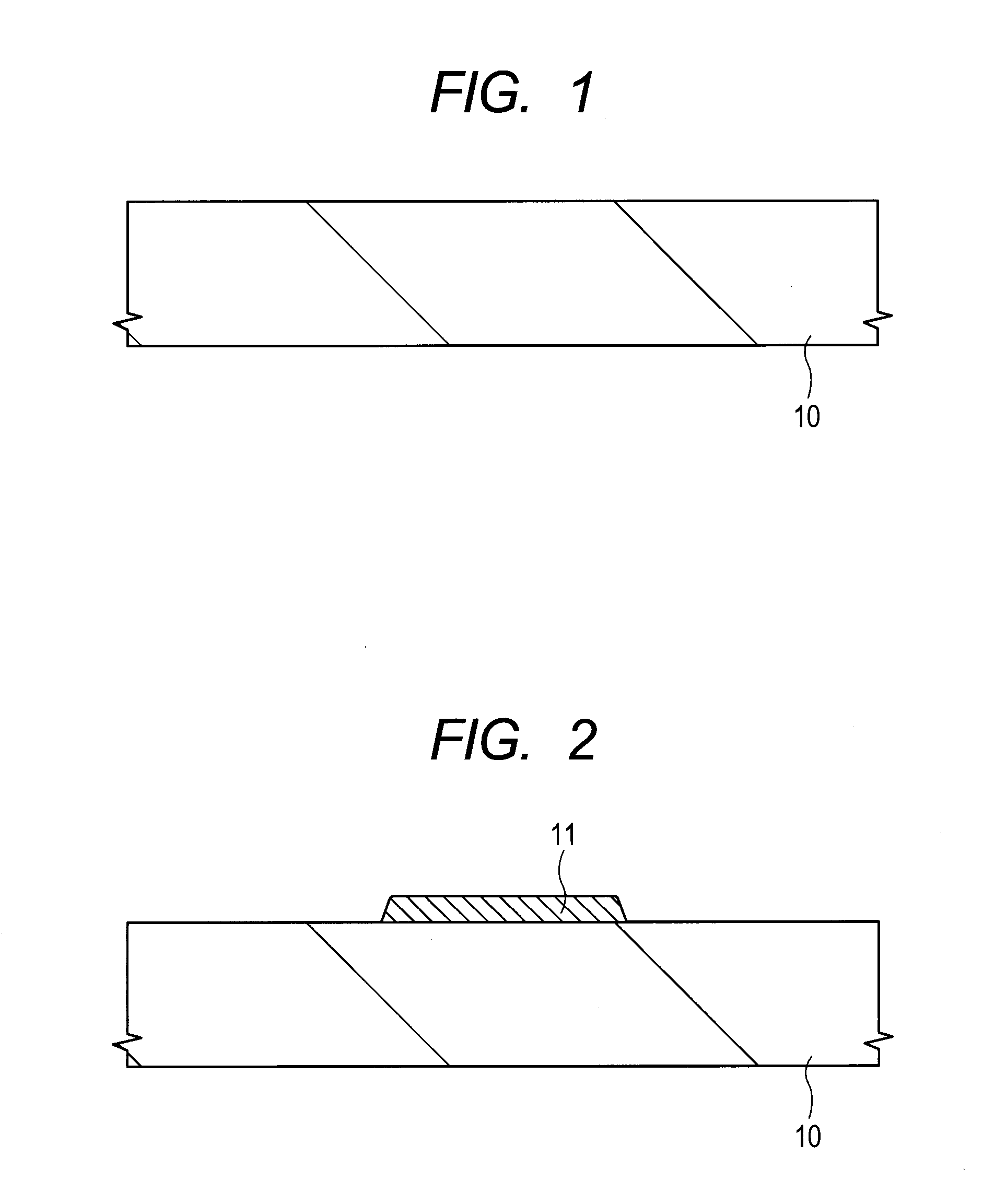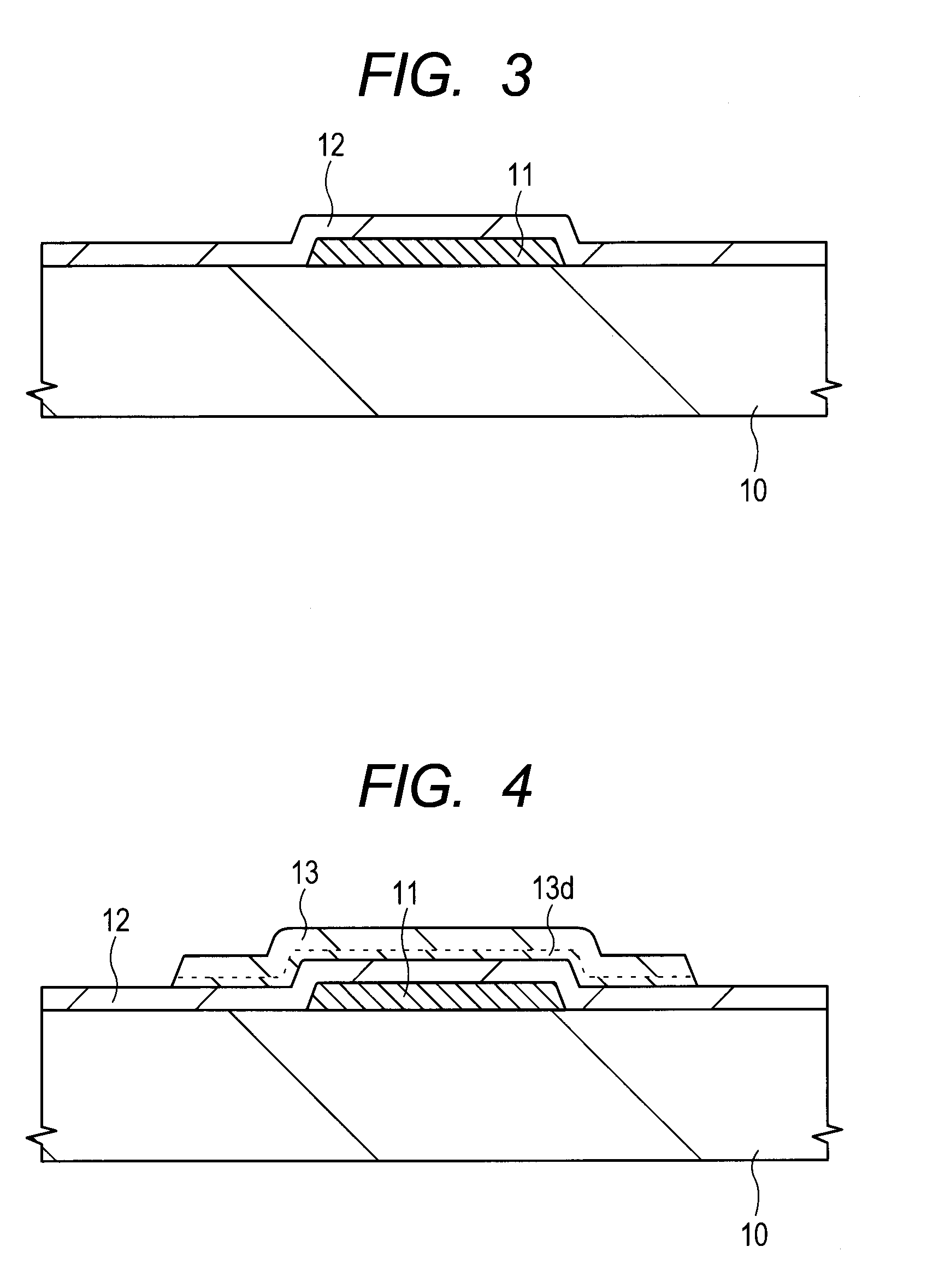Semiconductor Device, RFID Tag Using the Same and Display Device
a technology of rfid tag and semiconductor device, which is applied in the direction of semiconductor device, electrical apparatus, transistor, etc., can solve the problems of difficult to reduce standby power consumption, difficult to produce a fully depleted state, and difficult to operate at a low voltage of about 1 to 3 v, so as to achieve high field effect mobility and high on-current
- Summary
- Abstract
- Description
- Claims
- Application Information
AI Technical Summary
Benefits of technology
Problems solved by technology
Method used
Image
Examples
first embodiment
[0046]The first embodiment is applied to a bottom gate / top contact thin-film transistor. Here, “bottom gate” means a structure in which a gate electrode is located in a layer under a channel layer and “top contact” means a structure in which a source electrode and a drain electrode are located in a layer above a channel layer. Next, the method of manufacturing a bottom gate / top contact thin-film transistor will be described in the order of process steps.
[0047]First, as shown in FIG. 1, an insulating substrate 10 is provided. The material of the substrate 10 is, for example, silicon (Si), sapphire, quartz, glass, or flexible resin sheet (what is called plastic film). The resin sheet material is, for example, polyethylene terephthalate, polyethylene naphthalate, polyetherimide, polyacrylate, polyimide, polycarbonate, cellulose triacetate, or cellulose triacetate propionate. In addition, a substrate with an insulating coating on the surface of the above substrate material may be used a...
second embodiment
[0069]Using the same materials and processes as in the first embodiment, three types of thin-film transistors which have different film thicknesses of the high concentration region (13d), namely (1) 6 nm or less, (2) 20nm, and (3) 50 nm, were produced to study the relation between high concentration region film thickness and sub-threshold slope. Here, the difference between the maximum In concentration of the high concentration region and the In concentration of the other regions was 40 at % or more. FIG. 9 shows the result of the study. Also, for comparison, the relation between the film thickness of an oxide semiconductor layer of In—Ga—Zn—O (IGZO) and the sub-threshold slope is shown in FIG. 9.
[0070]As shown in FIG. 9, when the film thickness of the high concentration region is 6 nm or less, the sub-threshold slope is about 70 mV / decade, and when the film thickness is 20 nm, the sub-threshold slope is 100 mV / decade max. As the film thickness of the high concentration region incre...
third embodiment
[0073]For comparison in effect between the presence and absence of the high concentration region (13D), a thin-film transistor (sample A) having a high concentration region in the oxide semiconductor layer (13) and a thin-film transistor (sample B) having no high concentration region in the oxide semiconductor layer (13) were produced. The oxide semiconductor layer of sample A was made of In—Sn—Zn—O and the oxide semiconductor layer of sample B was made of In—Ga—Zn—O. The materials and processes used for the components other than the oxide semiconductor layer were the same as in the first embodiment.
[0074]FIG. 10 shows the result of analysis by a secondary ion mass spectrometer (SIMS) of composition distribution of constituent elements from the oxide semiconductor layer surface of sample A to the surface of the gate insulating film (12). From this figure, it is known that the oxide semiconductor layer of sample A has a high concentration region with a film thickness of about 6 nm an...
PUM
 Login to View More
Login to View More Abstract
Description
Claims
Application Information
 Login to View More
Login to View More - R&D
- Intellectual Property
- Life Sciences
- Materials
- Tech Scout
- Unparalleled Data Quality
- Higher Quality Content
- 60% Fewer Hallucinations
Browse by: Latest US Patents, China's latest patents, Technical Efficacy Thesaurus, Application Domain, Technology Topic, Popular Technical Reports.
© 2025 PatSnap. All rights reserved.Legal|Privacy policy|Modern Slavery Act Transparency Statement|Sitemap|About US| Contact US: help@patsnap.com



